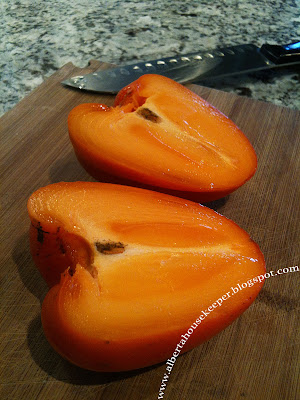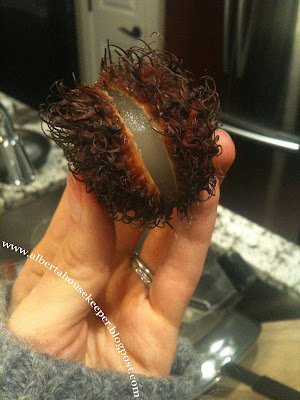 |
| Persimmon |
The other day, I ventured out grocery
shopping with a very particular goal in mind: find exotic fruit I have not yet
tasted and explore their nutritional value. I was curious to know how aromatic
Mexican guavas, tart Colombian tamarillos and sweet Taiwanese rambutans
compared with more common fruit and whether there were nutritional benefits to
seeking out these strangely named foods.
I theorized that although exploring exotic
fruit can be intriguing, all essential vitamins and minerals could be easily obtained
from foods commonly grown and consumed in Canada. From time to time, I hear of
so-called super foods with
alluring names and unique nutritional properties that are heavily marketed as
the solution to weight loss and every other human health issue. However,
worshiping any one particular food is fundamentally erroneous, as it devalues
more common alternatives and negates the supreme benefits of a varied diet.
In the recent months, Loblaw's Real Canadian Superstore has been doing a great job stocking
its shelves with more organic and exotic produce, so it became my first
destination. Marcus in the driver's seat of a large shopping cart, we
headed straight for the store's produce section and were immediately welcomed
by a large box full of ripe pomegranates. During the third trimester of my
pregnancy with Marcus, I found myself craving the blood-red seeds of this fruit
so much that I treated myself to at least one per day for several weeks. But
although very nutritious and less common than apples, pomegranates, grown as
close to BC as California, were not foreign enough for the purpose of this
comparison.
 |
| Rambutan |
In order to compare the fruit, I decided to create two separate tables- one for vitamins and another one for minerals- obtain the necessary data through USDA's National
Nutrient Database for Standard Reference and
compare it with the RDA (Recommended Dietary Allowance) specified in Health
Canada's Dietary Reference
Intakes Tables. All seemed rather straight forward until I got to work on populating table cells and realized that data on exotic fruit like tamarillos were either limited or altogether absent from the Nutrient Database and had to be obtained from alternative, often multiple, sources.
All in all, I utilized nine unique sources of data to build three tables, one of which specified ORAC (Oxygen Radical Absorbance Capacity) value of individual fruits, although I was unable to obtain it for four of twelve items. In essence, this measures antioxidant activity of various foods, and since vitamins are not the only compounds with antioxidant properties, the decision was made to include it as another way to compare the nutritional value of chosen fruit.
Fruit
|
Energy (kcal)
|
Fibre
(g)
|
Sugars
(g)
|
Vitamin A (IU)
|
Vitamin E (mg)
|
Vitamin K (µg)
|
EXOTIC FRUIT
|
||||||
Guava
|
68
|
5.4
|
8.92
|
324
|
0.73
|
2.6
|
Papaya
|
43
|
1.7
|
7.82
|
950
|
0.30
|
2.6
|
Persimmon
|
70
|
3.6
|
12.53
|
1627
|
0.73
|
2.6
|
Pomegranate
|
83
|
4.0
|
13.67
|
0
|
0.60
|
16.4
|
Prickly
Pear
|
41
|
3.6
|
9.57
|
43
|
0
|
0
|
Lychee
|
66
|
1.3
|
15.23
|
0
|
0.07
|
0.4
|
Starfruit
|
31
|
2.8
|
3.98
|
61
|
0.15
|
0
|
Tamarillo
|
33.5
|
3.45
|
3.85
|
630
|
1.95
|
0
|
COMMON FRUIT
|
||||||
Apple,
Gala
|
57
|
2.3
|
10.37
|
28
|
0.18
|
0
|
Banana
|
89**
|
2.6
|
12.23
|
64
|
0.10
|
0.5
|
Orange,
Navel
|
49
|
2.2
|
8.50
|
247
|
0.15
|
0
|
Pear,
Bartlett
|
63
|
3.1
|
9.69
|
28
|
0.12
|
3.8
|
RDA*
|
2481
|
25
|
N/A
|
2333
|
15
|
90
|
*Figures provided are RDA or AI (Adequate Intake), where RDA
is not available
**Figures in bold red indicate the highest values in the category
Due to difficulties obtaining nutritional data on particular fruits, they were replaced by similar varieties. For example, a rambutan was replaced with its close relative, lychee (litchi), and a native persimmon gave way to the Japanese (Oriental) variety. After some hesitation, I also included a pomegranate, simply to compare its vitamin K content with that of other fruit. Having been aware of its importance in calcium absorption and coagulation, or blood clotting, ever since my pregnancy with Marcus, I resolved to add it to the list of exotics.
Fruit
|
Vitamin C (mg)
|
Thiamin (Vitamin B1)
(mg)
|
Riboflavin (Vitamin B2) (mg)
|
Niacin (Vitamin B3) (mg)
|
Vitamin B6 (mg)
|
Folate (Vitamin B9) (µg)
|
EXOTIC FRUIT
|
||||||
Guava
|
228.3
|
0.067
|
0.040
|
1.084
|
0.110
|
49
|
Papaya
|
60.9
|
0.023
|
0.027
|
0.357
|
0.038
|
37
|
Persimmon
|
7.5
|
0.030
|
0.020
|
0.100
|
0.100
|
8
|
Pomegranate
|
10.2
|
0.067
|
0.053
|
0.293
|
0.075
|
38
|
Prickly
Pear
|
14
|
0.014
|
0.060
|
0.460
|
0.060
|
6
|
Lychee
|
71.5
|
0.011
|
0.065
|
0.603
|
0.100
|
14
|
Starfruit
|
34.4
|
0.014
|
0.016
|
0.367
|
0.017
|
12
|
Tamarillo
|
32.05
|
0.043
|
0.010
|
0.271
|
0.390
|
4
|
COMMON FRUIT
|
||||||
Apple,
Gala
|
0
|
0.017
|
0.029
|
0.075
|
0.049
|
0
|
Banana
|
8.7
|
0.031
|
0.073
|
0.665
|
0.367
|
20
|
Orange,
Navel
|
59.1
|
0.068
|
0.051
|
0.425
|
0.079
|
34
|
Pear,
Bartlett
|
4.4
|
0.012
|
0.026
|
0.164
|
0.026
|
0
|
RDA*
|
75
|
1.1
|
1.1
|
14
|
1.3
|
400
|
*Figures provided are RDA or AI (Adequate Intake), where RDA is not available
**Figures in bold red indicate the highest values in the category
 |
| Guava |
Fruit
|
ORAC (TEAC)
|
EXOTIC FRUIT
|
|
Guava
|
1018
|
Papaya
|
300
|
Persimmon
|
Unknown
|
Pomegranate
|
4479
|
Prickly
Pear
|
Unknown
|
Lychee
|
Unknown
|
Starfruit
|
Unknown
|
Tamarillo
|
1659.4
|
COMMON FRUIT
|
|
Apple,
Gala
|
2828
|
Banana
|
795
|
Orange,
Navel
|
1819
|
Pear,
Bartlett
|
1746*
|
Having considered all vitamin values, I determined that Mexican guava was a definite winner in four categories: fibre, vitamin C, niacin and folate content. At $3.98 per package of 600 grams, it is one of the less expensive exotic fruit and worth considering as a healthful addition to one's diet. By the same token, fibre, vitamin C and B-group (except from B12) vitamins can be obtained from other plant sources. For instance, vegetables like broccoli and Bell peppers are high in vitamin C and are significantly less costly.
Fruit
|
Calcium (mg)
|
Copper
(µg)
|
Iodine
(µg)
|
Iron
(mg)
|
Magnesium (mg)
|
Manganese (µg)
|
EXOTIC FRUIT
|
||||||
Guava
|
18
|
0.2
|
0
|
0.26
|
22
|
200
|
Papaya
|
20
|
0
|
0
|
0.25
|
21
|
0
|
Persimmon
|
8
|
0.1
|
0
|
0.15
|
9
|
400
|
Pomegranate
|
10
|
0.2
|
0
|
0.30
|
12
|
100
|
Prickly
Pear
|
56
|
0.1
|
0
|
0.30
|
85
|
0
|
Lychee
|
5
|
0.1
|
0
|
0.331
|
10
|
100
|
Starfruit
|
3
|
0.1
|
0
|
0.08
|
10
|
0
|
Tamarillo
|
12.6
|
0.086
|
0
|
0.445
|
22.3
|
149.5
|
COMMON FRUIT
|
||||||
Apple,
Gala
|
7
|
0
|
0
|
0.12
|
5
|
0
|
Banana
|
5
|
0.1
|
0
|
0.26
|
27
|
300
|
Orange,
Navel
|
43
|
0
|
0
|
0.13
|
11
|
0
|
Pear,
Bartlett
|
9
|
0
|
0
|
0.19
|
6
|
0
|
RDA*
|
1000
|
900
|
150
|
18
|
310
|
1800
|
*Figures provided are RDA or AI (Adequate Intake), where RDA is not available
Fruit
|
Molybdenum (µg)
|
Phosphorus (mg)
|
Selenium
(µg)
|
Zinc
(mg)
|
Potassium
(mg)
|
Chloride
(mg)
|
EXOTIC FRUIT
|
||||||
Guava
|
0
|
40
|
0.6
|
0.23
|
417
|
0
|
Papaya
|
0
|
10
|
0.6
|
0.10
|
182
|
0
|
Persimmon
|
0
|
17
|
0.6
|
0.11
|
161
|
0
|
Pomegranate
|
0
|
36
|
0.5
|
0.35
|
236
|
0
|
Prickly
Pear
|
0
|
24
|
0.9
|
0.12
|
220
|
0
|
Lychee
|
0
|
31
|
0.6
|
0.07
|
171
|
0
|
Starfruit
|
0
|
12
|
0.6
|
0.12
|
133
|
0
|
Tamarillo
|
1.2
|
36.95
|
0.1
|
0.16
|
408
|
0
|
COMMON FRUIT
|
||||||
Apple,
Gala
|
0
|
11
|
0
|
0.05
|
108
|
0
|
Banana
|
0
|
22
|
1.3
|
0.15
|
358
|
0
|
Orange,
Navel
|
0
|
23
|
0.7
|
0.08
|
166
|
0
|
Pear,
Bartlett
|
0
|
11
|
0
|
0.08
|
101
|
0
|
RDA*
|
45
|
700
|
55
|
8
|
4700
|
3600
|
*Figures provided are RDA or AI (Adequate Intake), where RDA is not available
**Figures in bold red indicate the highest values in the category
 |
| Prickly Pear |
However, once again, the elements and anthocyanins (phytochemicals with antioxidant properties) it contains can be obtained from alternative plant sources. It is also important to mention that micronutrient content of fruit varies depending upon the growing region, whether the fruit was picked ripe or not, how long it spent in storage and exactly what subspecies is being considered.
Therefore, there is no way of knowing precisely what is contained in any particular fruit at any given time. Neither is it realistic or necessary to remember nutrient content of every edible plant. Instead, adopting a varied diet with plenty of colour, taste and texture differences will ensure a full spectrum of macro and micronutrients for ultimate health.
Cited Sources:
http://www.princetonlivingwell.com/calculators/eer.aspx
http://www.hc-sc.gc.ca/fn-an/nutrition/reference/table/ref_macronutr_tbl-eng.php
http://www.hc-sc.gc.ca/fn-an/nutrition/reference/table/ref_vitam_tbl-eng.php
http://www.hc-sc.gc.ca/fn-an/nutrition/reference/table/ref_elements_tbl-eng.php
http://ndb.nal.usda.gov/ndb/foods
http://www.rambutan.com/Nutrition.html
The Nutritional Composition and Health Benefits of New Zealand Tamarillos, C. E. Lister, S. C. Morrison, N. S. Kerkhofs & K. M. Wright
New Zealand FOODFiles 2012 Version 01
http://www.oracvalues.com/
http://www.lenntech.com/about/aboutlenntech-en.htm
http://nutritiondata.self.com/
http://www.cancer.org/treatment/treatmentsandsideeffects/complementaryandalternativemedicine/herbsvitaminsandminerals/phytochemicals
http://umm.edu/health/medical/altmed/supplement/vitamin-k
